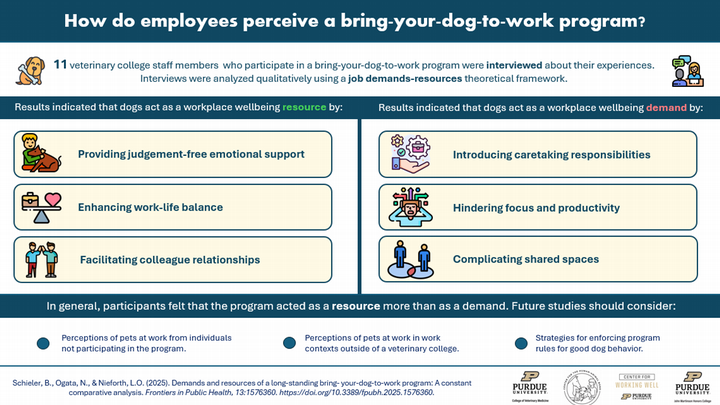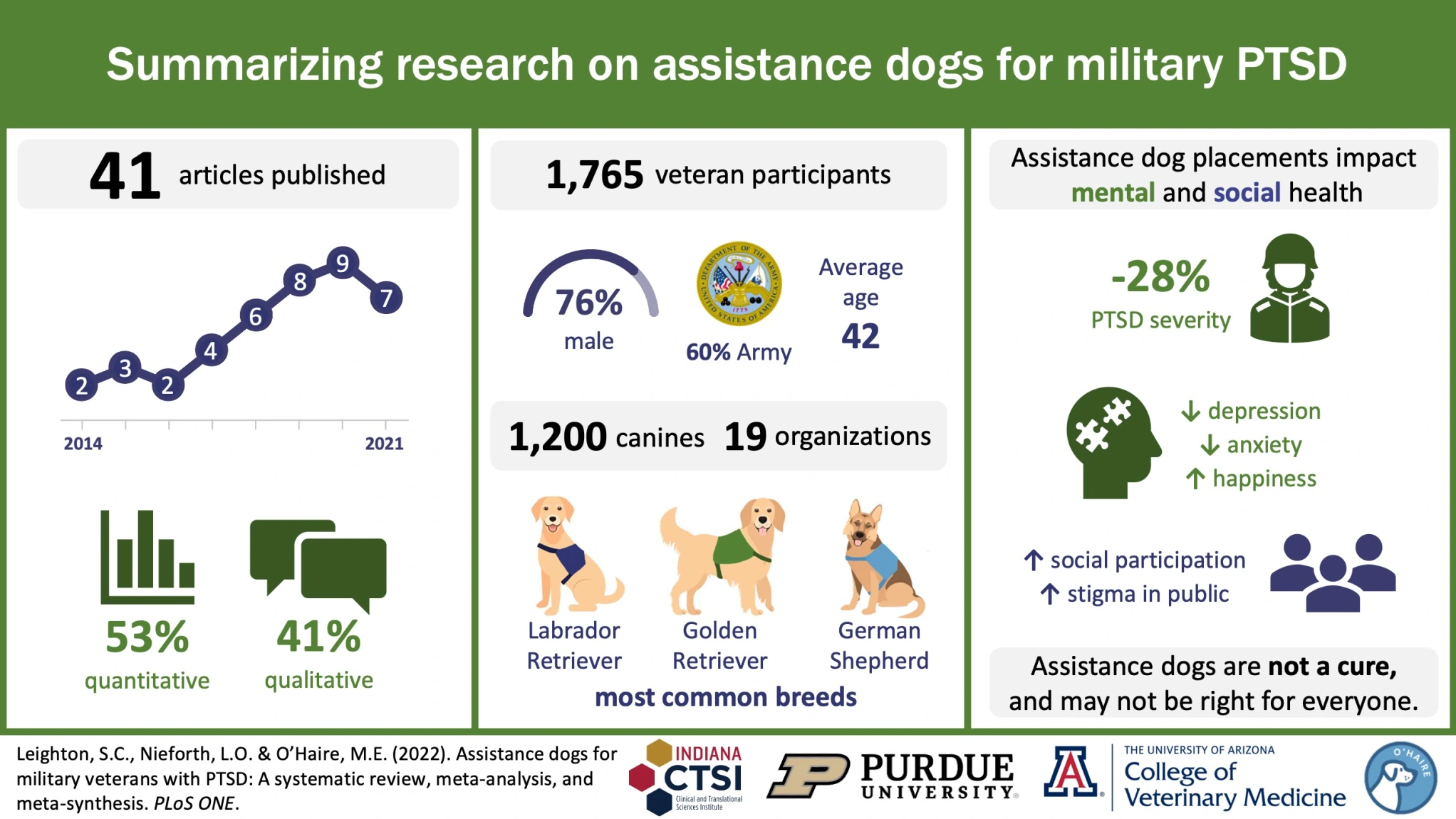
Human-Canine Interaction
Human-canine relationships date back an estimated 15,000-40,000 years with the domestication of the wolf (Serpell, 2021). Today, dogs hold many different roles within society. In addition to dogs being companions, they also have multiple working roles including assistance, protection, and detection (Hall et al., 2021). Many individuals view their canine companions as family members, as seen in a 2023 Pew Research Center survey of American households; this survey found that 62% of respondents have pets, 73% of which have at least one dog, with 97% of pet owners overall viewing those pets as family members. In addition to receiving companionship, safety, and physical support, interacting with dogs has been shown to have a number of social, emotional, and health benefits for humans, including reduction of stress, depression, and anxiety, and increases in happiness, motivation, emotional regulation, learning, cognition, and social functioning (Gee et al., 2021). Service dogs, also known as assistance dogs, in particular, serve a dual-purpose role as a working dog and a companion dog, providing support through their trained assistance tasks, as well as companionship and affection (Gee et al., 2021). Considering the long-standing, intertwined nature of human-canine relationships and the dependence on one another for health, safety, companionship, and support, it is crucial to understand the effects of human-canine interactions.
In the HAPI lab within the Center for the Human-Animal Bond, our research uses a biopsychosocial approach to understanding human-canine interactions, to support the development of practical and effective interventions for the benefit of both humans and dogs. Of particular interest are the effects and outcomes of pairing assistance dogs with veterans and civilians diagnosed with posttraumatic stress disorder (PTSD). The HAPI lab partners with a number of service dog organizations to understand these real-life impacts. Additionally, the HAPI lab studies the effects of interacting with dogs in a number of scenarios, including in educational facilities, within families, and in therapeutic settings.
Our Research

Show full text description
How do employees perceive a bring-your-dog-to-work program?
This infographic summarizes findings from a study of 11 veterinary college staff members who participate in a bring-your-dog-to-work program. Interviews were analyzed using a job demands–resources theoretical framework to understand how dogs affect workplace wellbeing.
Dogs as a workplace wellbeing resource:
- Providing judgement-free emotional support
- Enhancing work–life balance
- Facilitating colleague relationships
Dogs as a workplace wellbeing demand:
- Introducing caretaking responsibilities
- Hindering focus and productivity
- Complicating shared spaces
Overall, participants felt that the program acted as a resource more than a demand. Future studies should consider perceptions of pets at work among non-participants, other workplace contexts, and strategies for enforcing good behavior rules.
Schieler B, Ogata N and Nieforth LO (2025) Demands and resources of a long-standing bring-your-dog-to-work program: a constant comparative analysis. Front. Public Health. 13:1576360. doi:10.3389/fpubh.2025.1576360

Show full text description
How does a canine-assisted intervention affect children with ADHD?
Study Design
35 children with ADHD participated in a canine-assisted intervention combined with cognitive behavioral therapy. Participants were divided into two groups: one working with a toy dog and the other with a live dog.
Methods
Researchers analyzed 322 minutes of video-captured behavior data using the OHAIRE Coding System. The coded data were analyzed to identify significant behavioral differences between the groups.
Results
- Children showed changes in interaction with humans, specifically with adults, when a live dog was present over time.
- No statistically significant difference was observed in animal interaction between the groups.
Nieforth, L.O., Guerin, N.A., Stehli, A., Schuck, S., Yi, K.L., O’Haire, M.E.. (2024). Observation of human-animal interaction for research (OHAIRE) behavior coding in a randomized control trial of children with attention-deficit hyperactivity disorder (ADHD) and a canine-assisted intervention. Frontiers in Psychiatry. https://doi.org/10.3389/fpsyt.2024.1327380

Show full text description
Service dogs may impact stress physiology among veterans with posttraumatic stress disorder
Study Overview
This infographic summarizes a study examining whether service dogs affect stress hormone patterns in veterans with PTSD. A stress hormone found in saliva—cortisol—was assessed at two timepoints, three months apart.
Participants
The study involved 161 veterans with PTSD:
- 88 veterans had a service dog
- 73 veterans did not have a service dog
Methods
Researchers analyzed 2,613 cortisol samples collected from participants over the course of the study.
Results
Overall, veterans partnered with service dogs showed stress hormone patterns more similar to those of healthy adults without PTSD.
Nieforth, L.O., Rodriguez, K.E., Zhuang, R., Miller, E.A., Sabbaghi, A., Schwichtenberg, A.J., Granger, D.A. & O’Haire, M.E. (2024). The cortisol awakening response in a three-month clinical trial of service dogs for veterans with posttraumatic stress disorder. Scientific Reports. https://doi.org/10.1038/s41598-023-50626-y

Show full text description
How do psychiatric service dogs affect sleep of partners of veterans with PTSD?
Participants
The study included 88 partners of veterans with PTSD:
- 48 partners in the service dog group
- 40 partners in the usual care group
Data were collected at two time points: baseline and 3-month follow-up.
Methods
Sleep was assessed using both objective and subjective measures:
- Wristband actigraphy for objective sleep data
- Self-report and clinical survey measures for subjective sleep experiences
Results
There were no significant differences in sleep between partners in the service dog group and those in the usual care group.
- No benefits observed
- No harm identified
The findings suggest that service dogs may not meaningfully influence sleep for partners of veterans.
Nieforth, L.O., Leighton, S.C., Schwichtenberg, A.J., MacDermid Wadsworth, S. & O’Haire,
M.E. (2023). A preliminary analysis of psychiatric service dog placements and sleep patterns of partners of veterans with posttraumatic stress disorder. Anthrozoos. https://doi.org/10.1080/08927936.2023.2268979.

Show full text description
How do service dogs impact autistic children and their families?
Methods
The study involved 50 caretakers of autistic children who participated in a service dog program. Participants wrote about their experiences as part of the research.
Results: A Family Systems Approach
Findings revealed that service dogs improved family well-being both externally and internally:
External Improvements
- Improved social well-being for the family overall
- Enhanced and increased social interactions with others
- Decreased public stigma and judgment surrounding the family
Internal Improvements
- Strengthened and stabilized the family from within
- Provided individualized intervention for the child
- Built resilience as a member of the family
Overall, the study found that service dogs contributed positively to both social functioning and emotional well-being within families of autistic children.
Leighton, S. C., Rodriguez, K. E., Nieforth, L. O., O’Haire, M. E. (2023). Service dogs for autistic children and family system functioning: a constant comparative analysis. Frontiers in Psychiatry, 14:1210095. https://doi.org/10.3389/fpsyt.2023.1210095

Show full text description
PTSD service dogs foster resilience among veteran families
Participants
A total of 101 individuals completed an open-ended survey:
- 67 veterans
- 34 spouses
Findings
Qualitative analysis revealed that service dogs may:
- Build emotional reserves — described by participants as “gives me a reason to keep living”
- Increase relational load — described as “feels like caring for another child”
- Facilitate relational maintenance — described as “makes it easier to open up and reconnect”
Overall, the study highlights how service dogs can contribute to family resilience by influencing emotional and relational dynamics among veterans and their spouses.
Nieforth, L.O., Craig, E.A., MacDermid Wadsworth, S., Behmer, V. & O’Haire, M.E. (2023). PTSD service dogs foster resilience among veterans and military families. Current Psychology. doi:10.1007/s12144-021-01990-3

Show full text description
Summarizing research on assistance dogs for military PTSD
Publications
The systematic review identified 41 articles published between 2014 and 2021. Of these studies, 53% were quantitative and 41% were qualitative. The number of studies increased steadily over time, reflecting growing academic interest in this topic.
Participants
Across all studies, there were 1,765 veteran participants:
- 76% were male
- 60% were from the Army
- Average participant age was 42
Service Dogs and Organizations
A total of 1,200 canines from 19 organizations were involved. The most common breeds were:
- Labrador Retriever
- Golden Retriever
- German Shepherd
Findings
Assistance dog placements were shown to impact mental and social health:
- 28% decrease in PTSD severity
- Reduced depression and anxiety
- Increased happiness and social participation
- Some increase in public stigma
Researchers emphasize that assistance dogs are not a cure and may not be the right fit for every individual.
Leighton, S.L., Nieforth, L.O. & O’Haire, M.E. (2022). Assistance dogs for military veterans with PTSD: A systematic review, meta-analysis, and meta-synthesis. PLoS One. https://doi.org/10.1371/journal.pone.0274960

Show full text description
How do service dogs impact veteran spouses?
Study Overview
The study explored how service dogs affect the wellbeing of veteran spouses, an area that is often overlooked. Researchers emphasized that focusing on spouses supports the wellbeing of the entire veteran family.
Participants
88 spouses completed clinical surveys on wellbeing at baseline and again three months later. In comparison to 40 spouses on the waitlist, 48 spouses of veterans with service dogs reported the following outcomes:
Results
- Lower caregiver satisfaction
- Higher participation in activities
- Higher caregiver burden
Overall, while service dogs appeared to promote increased activity engagement, they were also associated with mixed effects on caregiver satisfaction and burden among spouses of veterans.
Nieforth, L.O., Miller, E., MacDermid Wadsworth, & O’Haire, M.E. (2022). The effects of a service dog on the wellbeing of veteran families. European Journal of Psychotraumatology. doi: 10.1080/20008198.2022.2062997

Show full text description
How do service dogs impact emotions of veteran spouses?
Study Overview
The study examined emotional wellbeing among 87 veteran spouses who completed daily emotional check-ins at both baseline and three months later.
Participants
- 39 spouses on the waitlist
- 48 spouses partnered with a service dog
Participants provided a total of 3,780 daily check-ins, completed twice per day over 14 days.
Results
Compared to the waitlist group, spouses with service dogs reported:
- Higher calmness
- Higher positive emotions
- Higher confidence
- No change in negative emotions
These findings suggest that service dogs are associated with improved emotional experiences for partners of veterans with PTSD.
Nieforth, L.O., Abdul Wahab,A.H., Sabbaghi, A.H., MacDermid Wadsworth, S., Foti, D. & O’Haire, M.E. (2022). Quantifying the emotional experiences of partners of veterans with PTSD service dogs using ecological momentary assessment. Complementary Therapies in Clinical Practice. doi: 10.1016/j.ctcp.2022.101590

Show full text description
Expectations versus Experiences of Veterans with PTSD Service Dogs
Study Overview
The study compared expectations and real-world experiences among 128 veterans who provided open-ended survey responses analyzed through thematic content analysis.
Participants
- 59 veterans on the waitlist for a service dog
- 69 veterans partnered with a service dog
Findings
Three main themes emerged when comparing veterans’ experiences to their expectations:
- Mental Health Benefits — improvements in wellbeing and coping with PTSD symptoms
- Human–Dog Interaction — strong emotional bonds and mutual support between veterans and their service dogs
- Drawbacks — practical challenges such as public stigma, training demands, or dependency concerns
Results provided insight into veterans’ personal experiences with PTSD service dogs and helped professionals better temper expectations and educate veterans about both the benefits and challenges of PTSD service dog programs.
Nieforth, L.O., Rodriguez, K.E. & O’Haire, M.E. (2021). Expectations versus experiences of veterans with posttraumatic stress disorder service dogs: A conventional content analysis. Psychological Trauma: Theory, Research, Practice, and Policy. doi:10.1037/tra0001021

